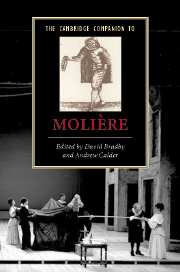Book contents
- Frontmatter
- 1 The career strategy of an actor turned playwright: 'de l’audace, encore de l’audace, toujours de l’audace’
- 2 The material conditions of Molière’s stage
- 3 The master and the mirror: Scaramouche and Molière
- 4 Molière as satirist
- 5 How (and why) not to take Molière too seriously
- 6 L’Avare or Harpagon’s masterclass in comedy
- 7 Laughter and irony in Le Misanthrope
- 8 Comédies-ballets
- 9 Le Bourgeois gentilhomme: Molière and music
- 10 Medicine and entertainment in Le Malade imaginaire
- 11 Molière and the teaching of Frenchness: Les Femmes savantes as a case study
- 12 L'École des femmes: matrimony and the laws of chance
- 13 Molière nationalised: Tartuffe on the British stage from the Restoration to the present day
- 14 Landmark twentieth-century productions of Molière: a transatlantic perspective on Molière: mise en scène and its historiography
- 15 Dom Juan the Directors’ Play
- 16 ‘Reculer pour mieux sauter’: modern experimental theatre’s debt to Molière
- Select bibliography
- Index
- Series List
7 - Laughter and irony in Le Misanthrope
Published online by Cambridge University Press: 28 March 2007
- Frontmatter
- 1 The career strategy of an actor turned playwright: 'de l’audace, encore de l’audace, toujours de l’audace’
- 2 The material conditions of Molière’s stage
- 3 The master and the mirror: Scaramouche and Molière
- 4 Molière as satirist
- 5 How (and why) not to take Molière too seriously
- 6 L’Avare or Harpagon’s masterclass in comedy
- 7 Laughter and irony in Le Misanthrope
- 8 Comédies-ballets
- 9 Le Bourgeois gentilhomme: Molière and music
- 10 Medicine and entertainment in Le Malade imaginaire
- 11 Molière and the teaching of Frenchness: Les Femmes savantes as a case study
- 12 L'École des femmes: matrimony and the laws of chance
- 13 Molière nationalised: Tartuffe on the British stage from the Restoration to the present day
- 14 Landmark twentieth-century productions of Molière: a transatlantic perspective on Molière: mise en scène and its historiography
- 15 Dom Juan the Directors’ Play
- 16 ‘Reculer pour mieux sauter’: modern experimental theatre’s debt to Molière
- Select bibliography
- Index
- Series List
Summary
Le Misanthrope, written in 1666 at the height of his career, is perhaps the most polished and thoughtful of Molière's plays. It offers us 1,800 or so alexandrines of conversation between elegant figures in a Parisian literary salon on the fringes of the court. It stands in counterpoint to the richly staged comédies-ballets and machine-plays, written initially for the court, which dominated Molière's output in the mid-to-late 1660s. Le Misanthrope was never performed at court. The play is difficult to place; it does not follow the conventions of literary or erudite comedy which dominated the comic stages of Italy, Spain and France in the Renaissance and seventeenth century. These, though immensely varied, followed more or less loosely the patterns of the Roman or New Comedy tradition of Plautus and Terence, in which complex plots contained tales of romance that, after many twists and turns, ended in universal rejoicing. Corneille's Le Menteur (1643) was one of the most elegant examples of the genre. Surprisingly perhaps, for all its polish and its focus on court circles, Le Misanthrope owed more to the traditions of French farce: as in La Jalousie du Barbouillé, probably the earliest of Molière's surviving one-act farces, the play portrays a battle of the sexes, a row between a would-be tyrant and a clever woman who deceives him; other smaller quarrels in Le Misanthrope echo the central one, each in turn imparting its vigour to the play's progress, none ending in reconciliation. Le Misanthrope also has features of the comédie-ballet. Key encounters in the play are expanded into elegant set-piece performances designed to entertain both the audience and other characters on stage. Two of these are paired readings, one of a sonnet and a popular song (I, 2) and another of two letters (V, 4).
- Type
- Chapter
- Information
- The Cambridge Companion to Moliere , pp. 95 - 106Publisher: Cambridge University PressPrint publication year: 2006



